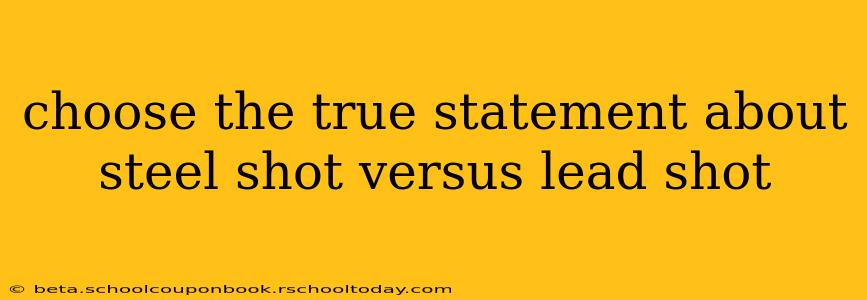Choosing the right shot for your shotgun can significantly impact your shooting experience and the environment. Steel shot and lead shot are the two most common options, but they possess distinct differences that affect their performance and legality. Understanding these differences is crucial for any responsible shooter. This article will clarify the key distinctions between steel shot and lead shot, helping you choose the best option for your needs.
Steel Shot vs. Lead Shot: Key Differences
The primary difference lies in their density and hardness. Lead shot is denser than steel shot, meaning it packs more weight into a smaller volume. This translates to higher energy transfer upon impact, leading to improved patterns and lethality at longer ranges. However, lead's softness can result in deformation during flight, potentially affecting accuracy.
Steel shot, conversely, is harder and less dense. This means it requires a higher shot size to achieve the same killing power as lead shot. While less dense, steel shot's hardness improves its ability to retain its shape during flight, contributing to a more consistent pattern at longer ranges.
Here's a breakdown of the key characteristics:
Density:
- Lead Shot: Higher density, leading to greater energy transfer at impact.
- Steel Shot: Lower density, requiring a larger shot size for comparable energy.
Hardness:
- Lead Shot: Softer, prone to deformation which can affect accuracy.
- Steel Shot: Harder, maintaining its shape better in flight for consistent patterns.
Environmental Impact:
This is a critical factor driving the shift away from lead shot. Lead is a toxic heavy metal that can harm wildlife and contaminate the environment, especially waterfowl. Steel shot is considered environmentally friendly as it is non-toxic and biodegradable.
Legal Considerations:
Many jurisdictions have restrictions or outright bans on the use of lead shot in certain areas, particularly wetlands and waterfowl hunting. Check your local regulations before purchasing or using either type of shot.
Which is Better: Steel or Lead?
There's no single "better" option; it depends on your specific needs and the context of use.
Lead shot's advantages:
- Higher density: Provides better penetration and lethality at longer ranges, especially with smaller shot sizes.
- More readily available (in some regions): Historically, lead shot has been more widely available and affordable.
Steel shot's advantages:
- Environmentally friendly: A major advantage for responsible shooters and conservation efforts.
- Harder and more consistent: Maintains shape better for improved patterns, especially at longer ranges (although higher shot sizes might be necessary).
- Often required by law: In many areas, steel shot is the only legal option for waterfowl hunting and other types of hunting near sensitive ecosystems.
Conclusion: Making the Informed Choice
Ultimately, the choice between steel and lead shot involves weighing environmental responsibility against performance requirements and legal limitations. Steel shot is increasingly the preferred choice due to its environmental benefits and its growing legal mandate in many hunting situations. Understanding the nuances of each type of shot ensures you can make an informed decision that aligns with both your ethical considerations and your hunting goals. Always check your local and federal regulations before using either steel or lead shot.
